BT-2
 Fast tank (1931) Soviet Union - 650 built
Fast tank (1931) Soviet Union - 650 built
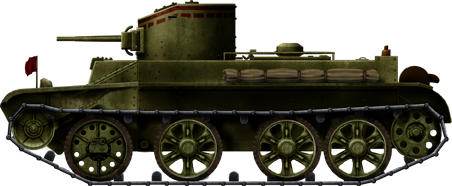
A revolutionary design
BT means Bystrochodnij Tankov (Fast Tank). It was indeed a new class of its own, originally invented and refined in the USA, as the brainchild of American Engineer Walter J. Christie, which had a tremendous influence in tank design during the thirties. Christie has observed WWI tanks in action and the beginnings of US tank postwar development at home. He had realized how deep was the gap between the fast armored cars, but with poor off-road capabilities, and the slow, but all-terrain proved tracked tanks. He devised new ways to cope with this problem, revolving around power-to-weight ratio and new suspension designs. His first prototype was ready in 1923, but was rejected by the US Army.He then developed even faster tanks, equipped with powerful radial aircraft engines and the acclaimed "Christie" suspension, as well as the concept of removable tracks. The idea was that, with this new suspension and the combination of very large rubberized wheels and huge vertical coils, his model remained operational even after its tracks were disabled, excessively worn or broken. The tank was also capable to reach the battlefield by itself, on roads, with its tracks stored on the mudguards, rather than to be carried by rail. It was displayed on impressive shows and quickly dubbed by the press "the race tank". However, the Army only ordered a single prototype for evaluation by the cavalry corps, the Christie model 1931, but further orders were cancelled.
The fastest tank on earth
Due to this setback at home Christie turned to the international market. His tank was displayed before scores of foreign governments. Among these was a Soviet commission, impressed by the stunning aerial performances of this model and the conversion in 30 minutes into a wheeled vehicle. They found it suitable both for the new tactics which were then in gestation back in USSR (the "deep battle" concept) and the bad roads and wide expenses of the Russian territory. However, since the US government had forbade such a purchase, the commission managed to ship them as "agricultural tractors", turretless and without any armament.Once in the USSR they were sent to the Kharkov Komintern Locomotive Plant (KhPZ) and, compared to formerly acquired plans, the design bureau managed to replicate several prototypes, called BT-2. The original Christie tanks were designated BT-1. The three BT-2 prototypes, delivered in October 1931, were still unarmed and turretless, but served as chassis test beds throughout 1932 and, at the fall of the year, mass production began. This was the first of a successful and unique lineage which lasted for a decade, including the BT-5 (1935) and BT-7 (1938-41), culminating with the BT-7M (more than 8000 machines), the ultimate offspring being the T-32 and the T-34.
The Bystrochodnij Tankov design
The KhPZ deign bureau headed by Morozov barely changed any features of the original BT-1 chassis and Christie design, concentrating instead on the engine, transmission, the turret and weaponry. The turret was of the simple "barrel type", a cylinder made of several layers of steel, 5-6 mm (0.2-0.24 in) in all, which was designed to house a 37 mm (1.46 in) long barrel, high velocity AT gun. It was not ready for production at the time and was later in chronically short supply.Because of this, many BT-2s were delivered with a mixed armament of DP-DT machines guns only or a 37 mm (1.46 in) gun with or without a single coaxial DT machine-gun. The standard configuration included the gun and a coaxial DT machine-gun mounted in an oblique fixed position, in the Japanese style. Its traverse depended on the turret. The "full machine gun" version consisted of a single coaxial DT machine-gun and a twin DP-28 (Degtyaryov model 1928) light machine gun mount replacing the gun. The other important point was the engine. The Soviets imported a licence for the American Liberty L12, a water-cooled 45° V-12 aircraft aircraft engine capable of 400 hp (300 kW), built as the M5-400. This first model, although powerful and light, was also found difficult to maintain and capricious. The power-to-weight ratio meant awesome performance, although less impressive than the original Christie M1932, mostly because of the added weight of the turret and all military equipment.
Production by KhPZ (Kharkov)
The first run and trials of the BT-2 were successful and showcased a road speed of 100 km/h (62 mph), with an offroad speed of 60-70 km/h (37-43.5 mph) depending of the terrain. They were largely showcased for propaganda purposes and featured in movies throughout the thirties. In 1933, it was completely new and unrivaled concept in the world, allowing "true" cavalry tactics built on speed, mostly for breakthrough exploitation and advanced reconnaissance missions. This emphasis on speed over protection also reflected the confidence in the naval "battlecruiser" concept, traduced in land warfare. The speed acted like an active protection on its own, since a target moving so fast was more difficult to hit.The M5 engine gave a 39 hp/t power-to-weight ratio and a 400 liters tank allowed a 300 km (186 mi) range at cruising road speed, with a tactical range of just 100 km (62 mi), also impressive for the time, giving that it was at an average off-road 60 km/h (37 mph). The Kharkov Komintern Locomotive Plant delivered 620 BT-2 until 1935. Most were equipped with the 37 mm (1.46 in) model 30 gun, provisioned with 96 rounds. Some also received a radio "horseshoe" antenna fixed on the turret. The latter had only two side small vision slits. The gun mantlet also varied slightly in shap during the production run. Another external modification included the front mudguards, not mounted on the earliest model, and headlights.
The BT-3 and BT-4
Before the production came to an end, the BT-3 was built according to Soviet specifications. These were virtually identical to the "regular" BT-2s, only differing by the use of the metric system for their construction instead of the old Imperial one. However this was only a factory designation, the army still registered them as BT-2s.The BT-4 was a true upgraded version with a partially welded hull and a modified suspension, only produced to three prototypes in 1935. These plans were altered for the upcoming, upgunned BT-5.
The BT-2 in action
The BT-2 "fast tanks" saw endless exercises in ruthless conditions, which worn off prematurely their already sensitive, even fragile engines. The 37 mm (1.46 in) gun proved accurate but lacked penetrating power compared to the new 45 mm (1.77 in) already used by the T-26. Thus came the idea of an upgunned version, later materialized as the BT-5. The BT-2s formed the backbone of cavalry units and were superseded in this role by the new BT-5s and BT-7s after 1936. Their baptism of fire came in Spain. A handful of BT-2s (from some sources) and BT-5s were sent to fight with the Republican army and easily overcame their opponents. Others were found in July-August 1939 at the Nomonah plateau and played a major part in the Battle of Khalkhin Gol, alongside better armed BT-5s.By 1940, veterans of both campaigns argued to make their tactical vision adopted, but the Nomonah veterans faction led by Zukhov came into favor only on the aftermath of the disastrous Winter campaign. Bad coordination between the air force, tanks and infantry, combined with a Finnish resolute defense, led to crippling losses, and the BT-2s were no exception. Some took part in the Soviet invasion of Poland, but by the summer of 1941, perhaps half of their original numbers were still available, so their apparition on the battlefield was almost a rarity. The crew unanimously preferred the better armed and more reliable BT-5s, although the BT-2 remained until the end of the war the fastest tank in service. Such performances were unmatched until the arrival of the third generation of MBTs in the 90s.
BT-2 specifications |
|
| Dimensions (L-w-h) | 5.58 x 2.23 x 2.2 m (18.3x7.32x7.21 ft) |
| Total weight, battle ready | 10.2 tons |
| Crew | 3 (commander/loader, gunner, driver) |
| Propulsion | 8-cyl petrol KhPZ M5, 400 bhp (298 kW) |
| Speed | 55 km/h (39.2 mph) |
| Range (road/off road) | 200 km (120 mi) |
| Armament | Main: 1 x 37 mm (1.46 in) model 33 gun
Secondary: 1/2 DT 7.65 mm (0.3 in) machine-guns |
| Armor | 6 to 12 mm (0.24-0.47 in) |
| Production | 650 |
Links and references :
The BT tanks on WikipediaThe BT-2 on wwIIvehicles.com
The BT-2 on battlefield.ru

BT-2 1932 model, 37 mm (1.46 in) gun only.
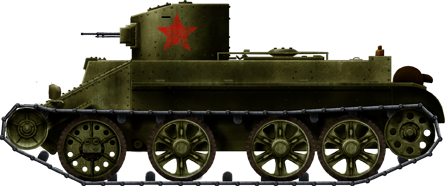
A BT-2 1932 model, twin DT machine-gun variant.
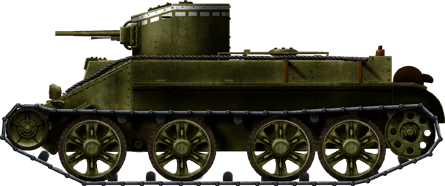
BT-2 at the battle of Khalkin Gol, August 1939.
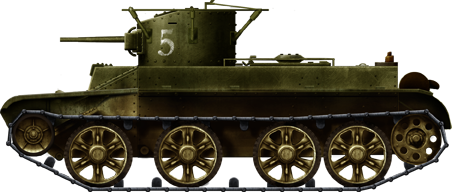
BT-2 command tank, invasion of Poland, September 1939.
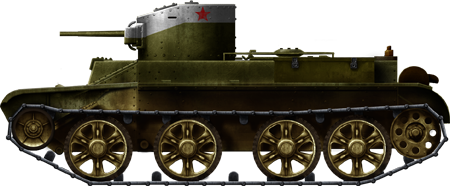
BT-2 of the reserve force, 1940.
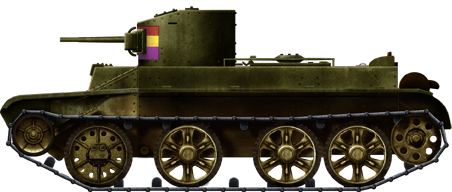
BT-2 in Spain, Republican Forces, battle of Madrid, 1937.
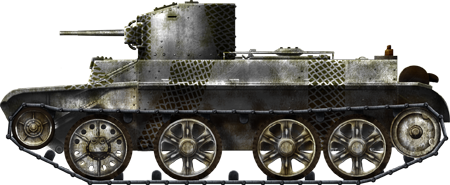
Winter war, Karelian front in eastern Finland, December 1939.
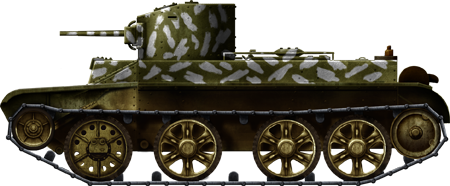
A BT-2 during the battle of Moscow, winter 1941/42.

WW2 Tanks




























WW2 tanks posters

All Tiger tanks liveries.

Panther liveries and variants

WW2 Armour - All tanks











Tanks aces and single tanks series

Find more there

Museums, Movies, Books & Games
The Tanks and Armor in pop culture
Tanks and armored vehicles in general are only really grasped when seen first person: The mass, the scale, it's all there. Explore also the way tanks were covered in the movie industry, in books and in video games.Movies:
Best tanks movie on warhistoryonline.com
On imdb.com
On bestsimilar.com/
miltours.com
liveabout.com/
watchmojo.com
Video Games:
pcgamesn.com
historyhit.com
levvvel.com
vg247.com/best-tank-games
mmobomb.com/
alienwarearena.com
